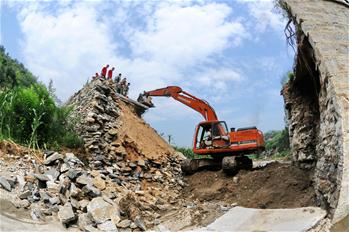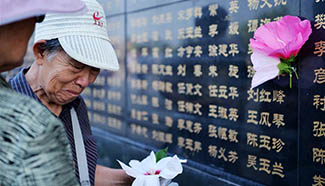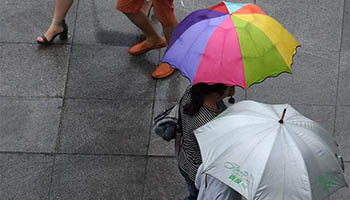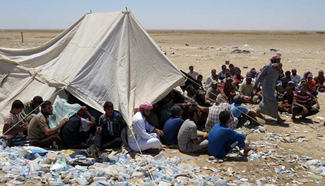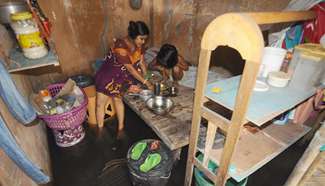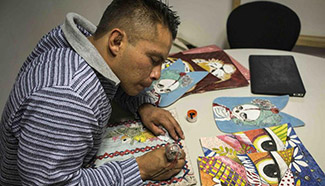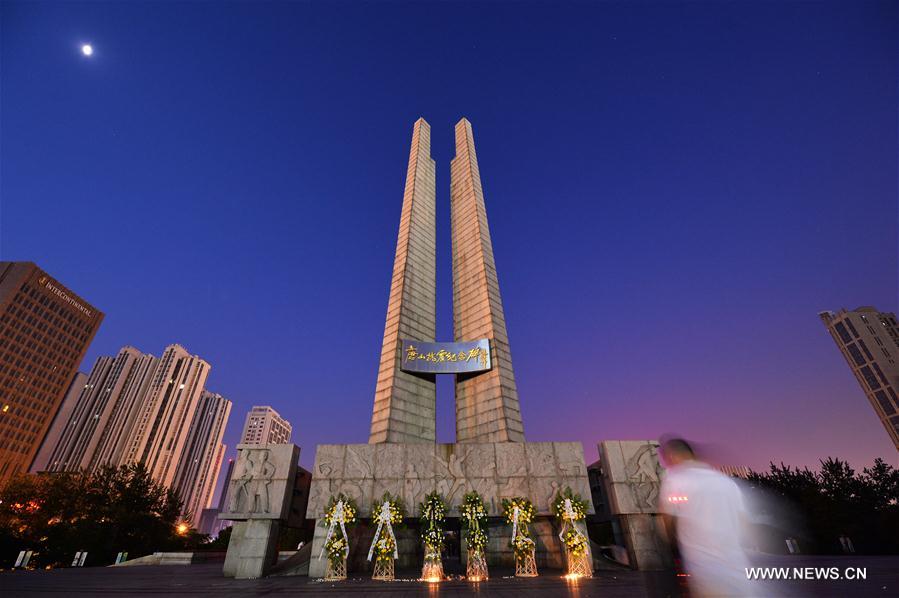
A citizen mourns for relatives killed in the 1976 Tangshan earthquake in front of the Earthquake Monument in Tangshan, north China's Hebei Province, July 28, 2016. In the early hours of July 28, 1976, a 7.8-magnitude earthquake struck the city in Hebei Province, killing over 242,000 people. Local residents came to the Tangshan Earthquake Ruins Memorial Park and the Earthquake Monument to show love to their deceased family members and friends on Thursday. (Xinhua/Zhao Liang)
TANGSHAN, Hebei Province, July 28 (Xinhua) -- Standing on the rubble of Tangshan 40 years ago, orphan Zhang Dongyi saw his world collapse, and so did the city in northern China's Hebei Province.
Forty years later, Zhang, 54, is a senior technician with the Tangshan branch of the China Railway Rolling Stock Corporation (formerly the Tangshan rolling stock plant).
"The past four decades have changed a lot," he said.
"From destruction to prosperity, Tangshan is a miracle."
The year 1976 was tragic for China. Three of its most venerable leaders, Mao Zedong, Zhou Enlai and Zhu De all died in the year. In the early hours of July 28, one of the deadliest earthquakes of the 20th century razed the city of Tangshan, killing more than 240,000 people and injuring another 160,000.
THE QUAKE
Thursday is the 40th anniversary of the disaster.
Zhang remembered being just a regular naughty boy before the quake, but then everything changed.
"Life was carefree until that day," he said.
Before the quake hit, Zhang was watching a movie, which was about the thoughts of Chinese Chairman Mao Zedong. In Zhaogezhuang village, where he lived, people were noticing that things seemed unusual somehow.
"Water in the wells was muddy, and chickens refused to return their sheds," he said.
"Some of them even flew up into trees." But the villagers didn't realize what was in store for them.
At midnight, he was awaken by a violent shake. Outside his window, he saw lightening and trees being uprooted in strong winds. Zhang fell to the ground.
Before he could get up, his house collapsed. It was 3:42 a.m.. When he was rescued at dawn, he found he had injured his nose; you can still see the scar to this day. His sisters were injured and sent to hospital, while his parents died after the roof collapsed on them.
In Zhaogezhuang, 400 out of a 1,000 villagers died in the quake. The Tangshan rolling stock plant where Zhang's father worked, founded in 1881, was destroyed.
In the disaster Liu Jiang lost his father. The then 20 year-old miner was installing equipment in the mineshaft when he felt tremors that made it difficult for him to stand.
"The first thought that came to my head was war," Liu said.
The earthquake cut off the power supply and disabled elevators. They went back up to ground-level only to find all the buildings surrounding the mine had collapsed.
"Corpses and injured people were everywhere, and the water became red," he said.
Survivors joined in the rescue efforts. Without advanced equipment, they dug out more than 16,000 people with their bare hands.
REBUILDING
Despite a severe shortage of resources and only 10 percent of the world average GDP per capita, China was determined to carry out the post-quake rebuilding without the help of other nations.
Only five hours after the quake, Feng Lindi, a steel worker, returned to his workshop.
"Nowadays you might question my motives, but in those days people had faith," said Feng.
"We heard of Western media reports saying Tangshan had vanished from the surface of the earth, and we were determined to show the world we had not."
On August 25, four weeks after the quake, steel bars rolled out from the furnace at Feng's workshop.
"We swarmed to the platform at the foot of the furnace, laughed, cried and shouted 'Long live Chairman Mao'," he said.
"It's a mixed feeling you won't understand."
Slowly but surely, homes, factories and public facilities were rebuilt. The central government allocated 500,000 tonnes of steel, 500,000 cubic meters of lumber, 2.5 million tonnes of cement, and more than four billion yuan to facilitate the post-quake rebuilding.
"At least 120,000 construction workers were hired from neighboring cities in Hebei to help with the civil construction, as many local workers had died in the quake," said Chang Qing, a 82-year-old photographer who has recorded Tangshan's reconstruction for four decades.
Altogether 650,000 homes were destroyed in the quake and not a single building remained standing.
"Tents were set up on the ruins and there was no empty ground in the city for new homes to be built," said Chang.
"Reconstruction had to start in the suburbs, and sprawl to the city center after residents had moved into new settlements in the outer areas."
For eight years, Chang's family lived in a small prefabricated house. In the hardest days, they lived on food relief and rain water from a muddy pond. For many months there were no fresh vegetables, and pickles were their only dish.
"There were 23 people from five families in the neighborhood, mostly women and orphans. I was one of only three healthy men able to do the tough jobs such as carrying fuel or cutting firewood," said Chang. "Together we helped ourselves in order to survive."
Two years after the quake, China started its reform and opening up.
"Reform accelerated China's development and spurred industrial growth in Tangshan, a city famous for its resources and chemical industries," said Professor Gao Minjie from the Tangshan Party School.
Businesses in Tangshan kept expanding in the post-quake era, spurred on by a growing demand for coal, steel and other resources.
The state-owned Kailuan Mining Group began sending its workers on training tours to Japan, Europe and America in the early 1980s.
A Tangshan-based overseas engineering company won its first international contract in 1985.
The first high-rise building, the Tangshan Hotel, was built in 1983, but was soon overtaken by the countless skyscrapers that make Tangshan the modern city it is today.
"Every new building is a monument," said Chang, who still records the city's changes with his camera.
"It's a relief I can do something for the sake of those who died in the quake -- the new city was built on top of them."
TRANSFORMATION
After the quake, Tangshan spent one decade on reconstruction, one decade on revitalizing, and two decades going through rapid economic growth, said Jiao Yanlong, party chief of the city.
"As a resource-oriented industrial city, Tangshan has to speed up the transformation of economic growth and restructuring, and improve the quality and efficiency of development," Jiao said.
Relying on heavy industry as its mainstay, the city has been plagued by emerging problems such as overcapacity and pollution during development.
Tangshan has contributed to half of the steel production capacity in Hebei, one of the world's major steel-production bases
"Hundreds of steel plants were built in Tangshan at the peak time but only a dozen of them can surpass an annual output of one million tonnes," said Wang Jianping, a retired steel worker.
Plenty of resources have been consumed by these iron and steel factories, but they often pollute water and generate harmful emissions.Under such circumstances, many have turned their eyes to a greener economy.
Ye Jinbao was owner of an iron and steel factory in Qianan city,Tangshan. Overcapacity and cut-throat competition forced Ye to sell his factory, and he vowed he would never again make a living from projects that caused heavy pollution again.
He spent nearly 500 million yuan (75 million U.S. dollars) constructing a manufacturing base for his new biopharmacy business in 2010.
With an annual investment of more than 50 million yuan in research and development, his new company has recorded profits since 2015.
Zhang Dongyi remembered having a difficult time in the 2000s, before his company sent technicians to study in Germany. They came back with the advanced technology and knowledge that enabled them to produce high-speed trains.
In 2015, the city's GDP reached 610 billion yuan, 73 times what it was 40 years ago.
By the end of 2015, it had reduced production capacity by 10.9 million tonnes of iron and 23.6 million tonnes of steel. That year, the number of days with serious pollution was 42 times less than in 2013, and PM2.5 dropped by over 26 percent.
COMMEMORATION
Liu Jiang can see the changes in Kailuan.
"It was dirty in the past. When it rained, water on the ground became mud. Now even the mineshaft is as clean as a station hall," he says.
Many more changes can be seen in Tangshan.
On the site of Zhang Dongyi's destroyed home in Zhaogezhuang, now sits South Lake park, venue for the Tangshan International Horticultural Expo.
Looking into the future, Tangshan is ambitious.
Wang Chunyan, vice head of the Tangshan city planning bureau, told Xinhua that it was a goal of Tangshan to become a core part of the Beijing-Tianjin-Hebei integration.
"We will become an important city for regional economic cooperation in northeast Asia, with a new industrial base and an international cargo port," she said.
In some parts of the city, however, time seems to frozen at that tragic moment from 40 years ago.
The ruins in former Tangshan rolling stock plant are preserved as part of the Tangshan Earthquake Memorial Park, where a black wall was built for survivors to mourn and remember the dead. Many of the names of the dead are inscribed on the wall, though many names are missing.
On quake anniversaries many people gather here, some cleaning bricks where names of their beloved are inscribed, others gently whispering to the wall, their pain never fully going away.
Zhang Dongyi never visits the park at such times.
"The occasion makes my heart ache," he said.
For him, commemoration is something private.
Several years ago, he burned a letter to his parents in heaven, in which he told them how he entered his father's company, and became a senior technician, and now has apprentices of his own.
"Father told me to work hard, and mom wanted me to be a good man, which I have always remembered."




